Costume Designer Mark Bridges Makes Inherent Vice Look Nice
“She came along the alley and up the back steps the way she always used to. Doc hadn’t seen her for over a year. Nobody had. Back then it was always sandals, bottom half of a flower-print bikini, faded Country Joe & the Fish T-shirt. Tonight she was all in flatland gear, hair a lot shorter than he remembered, looking just like she swore she’d never look.”
So begins Thomas Pynchon’s “Inherent Vice,” five quick sentences that describes a change in the air and atmosphere of Los Angeles, and for our protagonist, detective Doc Sportello, seen through the clothes a young woman wears. Among the hundreds of decisions director Paul Thomas Anderson and his creative team had to make when they adapted Pynchon’s book, few would be as crucial, and as evident to the viewer, as the wardrobe these colorful characters donned.
And the man who needed to turn descriptions like these, figure out how to take what was on the page and make it pop on screen, was costume designer Mark Bridges.
Bridges was up to the task. He’s the man who put Daniel Day-Lewis in jodhpurs in There Will Be Blood, Philip Seymour Hoffman in a red robe in The Master and Bradley Cooper in a Philadelphia Eagles jersey (at a dinner party!) in Silver Linings Playbook. He nabbed an Oscar for his work on The Artist in 2011, and now it’s Inherent Vice, his sixth film with director Paul Thomas Anderson. Including the aforementioned films, he also designed the look for the characters in Magnolia (Tom Cruise’s power vest!), Boogie Nights (pretty much everything everyone wears was incredible), Punch Drunk Love (Adam Sandler’s blue suit, which he wears practically the whole film) and Hard Eight (Gwyneth Paltrow’s sequined, low-cut dress).
No matter what the project, Bridges begins by looking for the essential element that makes each tick. In There Will Be Blood, of the many items that Day-Lewis’s Daniel Plainview wears, it was his hat that Bridges used to signal the character’s seething ambition. Bridges told The Washington Post that he gave Day-Lewis three to choose from, and so the actor spent time with all of them before choosing the one that fit. “You knew he was Daniel Plainview once that hat went on,” Bridges said. “And by the way, the sweat stains are real.” In Inherent Vice, the challenge was that there every single character has some kind of distinctive quality that Bridges need to tease out to fit their look.
“I started by reading the book, then the script, then making notes, then looking at a lot of images from the era,” he said in the production notes. He pored over photos, paintings, films and illustrations to find the right styles. Bridges took all the research and began to imagine where his characters would shop, how they might present themselves to the world, and how they fit into the larger picture of 1970s Los Angeles. “I was also starting to think about how this period might look fresh and interesting yet accessible to an audience today.”
Bridges made a look book for Anderson, and they took time to discuss the right feeling and tone for each character’s look. “By the time each actor came in for a first fitting, Paul and I already had a few directions we could take a character,” he says in the production notes. “Then I worked directly with the actors, looking at how different things fit and trying to give them everything they needed to feel comfortable inhabiting their particular world and role. It was like putting a big puzzle together, piece by piece.”
Pynchon’s imagery gave Bridges a lot of vivid images to work with: Jade’s cocktail waitress look that she wears at her massage parlor, Dr. Blatnoyd’s suit, and Coy’s disguise to name a few. Going back to Pynchon’s fantastic opening for the novel, the line that struck Bridges was about Shasta was “looking like she said she’d never look.”
“That’s where I go to work as a costume designer,” he said. “What does that phrase mean for a girl that had previously lived on the beach in only a bikini and a tee? What would she need to wear to fit into Micky Wolfmann’s world, suddenly living in Hancock Park, going on auditions, maybe hanging out in Beverly Hills? I felt a crochet dress was the right choice to represent that phrase because it was a lot of things at once: tasteful yet sexy, mod yet classic and, to me, very 1970. It’s also very different from that bikini bottom and tee worn during her life with Doc.”
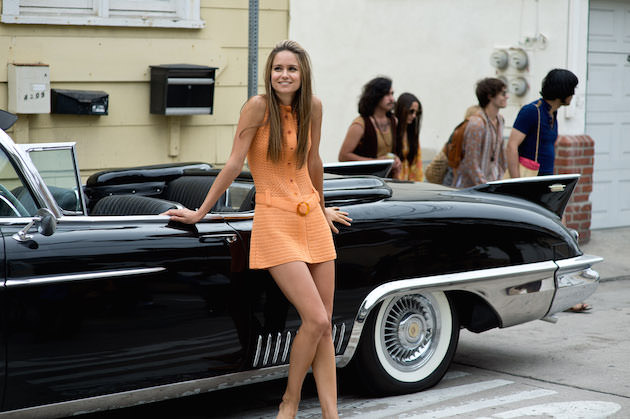
Bridges and his team scouted vintage items and handmade garments that were specific to the characters. “Shasta’s crochet dress was an original dress from the period found in an antique mall—a lucky find since most crochet dresses from the period have not survived these last 45 years,” he said. “I dyed it a bit to make the color stronger and more appealing yet still accurate for the period. We had to be very careful handling it, it was such a unique piece.”
Pynchon writes that Dr. Blatnoyd wears an “ultraviolet” velvet suit, so Bridges played with several shades of purple. “I had Rudy Blatnoyd’s suit made in two different colors of velvet, one a very strong blue/purple—what I consider Pynchon ‘ultraviolet’—and the other in a ‘groovy’ plum color. Paul and I looked at the two choices on Martin Short and decided in the moment on the groovy plum. I was very happy with how it worked in the wood paneled office and with Japonica’s yellow dress.”
For Dr. Blatnoyd’s velvet suit, Bridges went with a homemade version based on a vintage prototype. As for Jade’s dresses, they were all bought in Chinatown and then altered into shapes that were appropriate for the era.
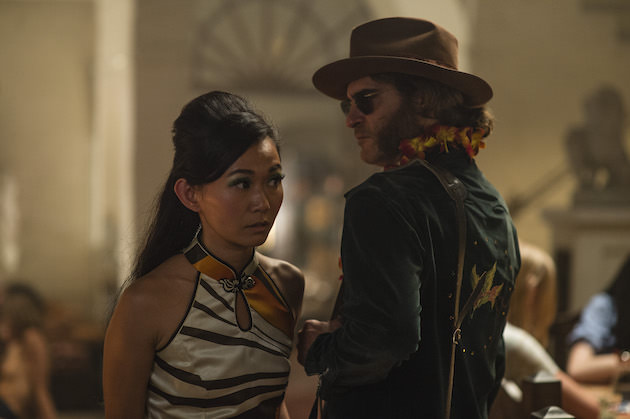
And what about Doc himself? Bridges so in him something of a “Neil Young iconoclast—scruffy, laidback, a bit frayed and almost accidentally cool,” as the production notes have it. Bridges said Young’s influence ran through all of Phoenix’s costumes. “Many times when I needed an idea for Doc I would look at Neil’s choices during that era and often find a unique period look that was great then and still looks great today,” he said.
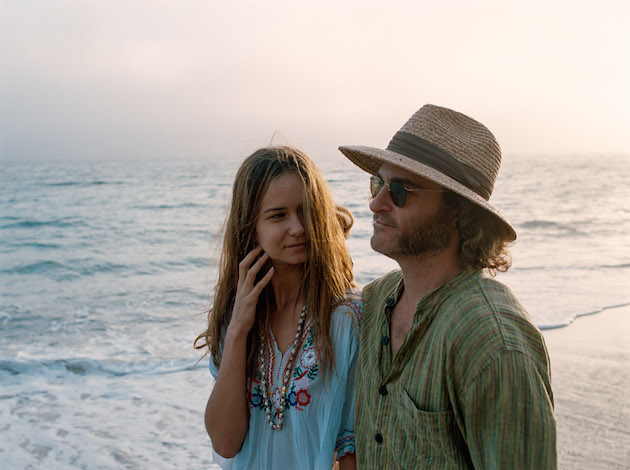
Inherent Vice follows more characters than just the dopers, surfers, skirt-chasing dentists, Golden Fang syndicate members, massage parlor managers and the rest of the seedy underbelly of L.A. The straighter side of the city emerges in the brutal and business like-looks of defective detective Bigfoot (Josh Brolin), Deputy D.A. Penny Kimball (Reese Witherspoon and Crocker Fenway (Martin Donovan). “Bigfoot, Penny and Crocker represent The Establishment, the complete opposite of the world Doc inhabits. The cultural divide at the end of the `60s was so great that during my research I even found an advertisement for The Establishment Wig, a wig to wear over your long hair when ‘short hair is a must!’”
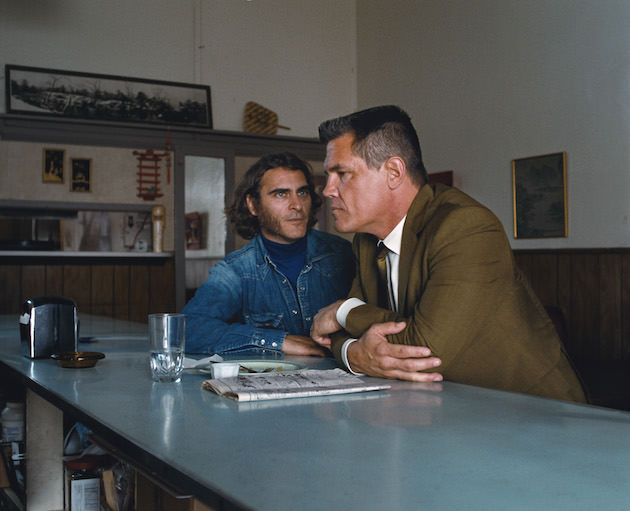
Josh Brolin’s look harkens back to the groomed detectives of a prior era. “Bigfoot’s basic look is about 10 years earlier than 1970,” Bridges said. “He’s wearing a more early `60s suit silhouette, but I amped up the period colors in his costumes as the story goes on, so you start seeing him in the salmon-colored shirt and then the bronze suit for his final scene in the film. That suit was actually inspired by Lee Marvin’s look in the 1967 film ‘Point Blank.’”
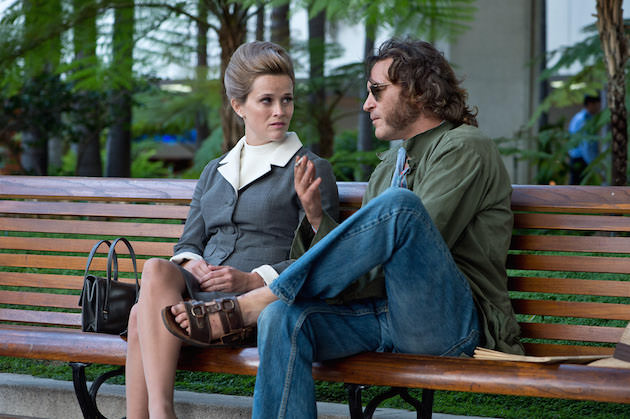
Bridges put Reese Witherspoon’s Penny in a wardrobe that acted as a kind of shield. “I love to use contrasts to play up the idea that a character’s clothing isn’t always who they really are, just how they want the world to see them,” Bridges said. “The first time we see Penny, she’s in a double-knit dress and jacket ensemble with a high collar, which I designed for Reese. But then we see Penny later in the film in a much different look at Doc’s house. Penny’s navy and white dress was inspired by a pair of vintage shoes I found—and the length and shape of her skirts were inspired by Faye Dunaway’s costumes in 1968’s ‘The Thomas Crown Affair.’”
Inherent Vice opens today.



